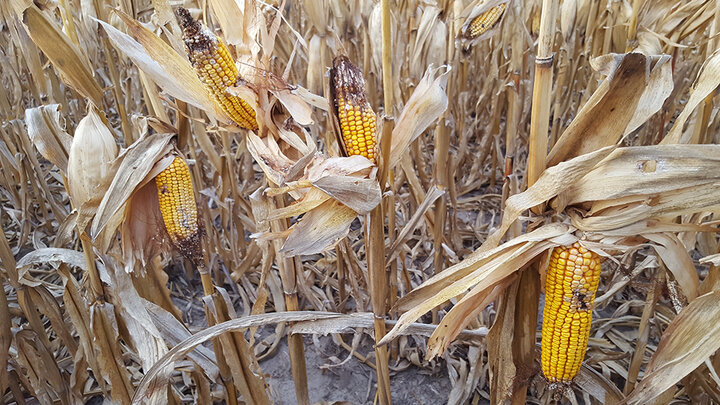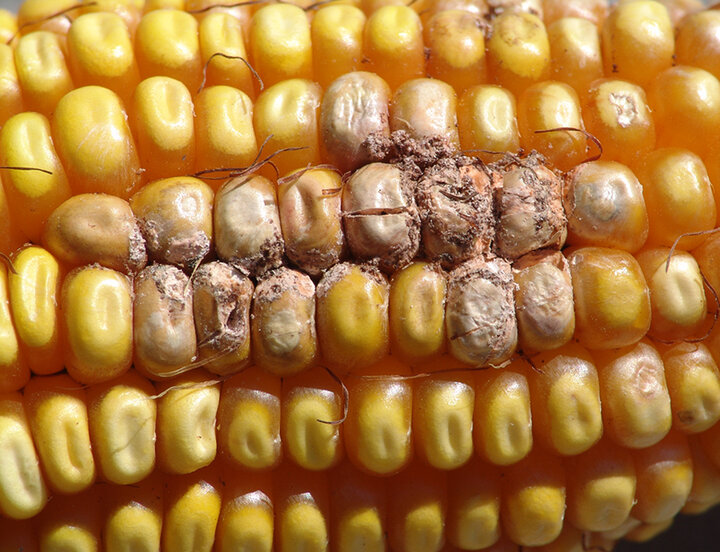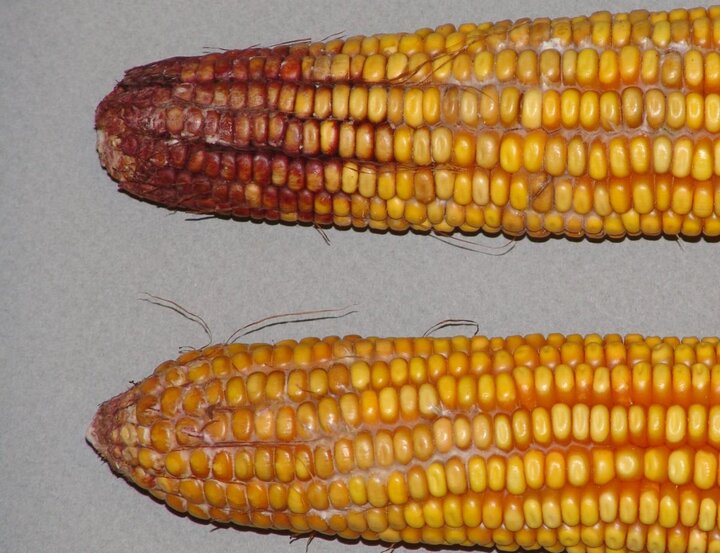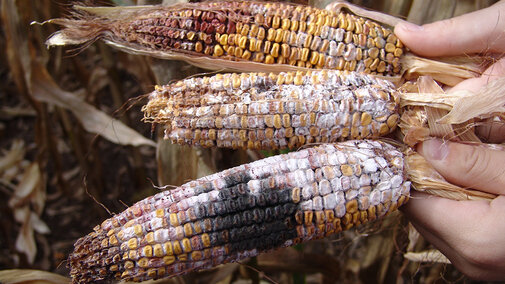Stalk and ear rot diseases continue to become more evident in many cornfields across Nebraska where prolonged periods of wet weather have delayed corn harvest. Producers should monitor for diseases in their fields and make decisions about which fields should be harvested first/early to avoid losses due to lodged corn. This information should also help them determine how to handle corn at harvest.
A high incidence of stalk rot diseases is evident in many fields and with stalk strength further compromised due to wet conditions. Wet conditions not only favor the fungal pathogens causing common stalk rot diseases, but also the common and beneficial microbes that have already begun to decompose dead plant tissue. These changes have likely been accelerated during the last week or more of rainy/foggy conditions that delayed harvest. Darkening and general discoloration of the standing crop can be another warning sign.
Stalk rot diseases are common and often develop in fields that have undergone stressful growing conditions. Corn lodging that results from stalk rot diseases can cause complications during harvest and loss of grain on the ground or grain quality issues. Pay special attention to fields that have one or more of the following risk factors for stalk or ear rot diseases (Figure 1) and lodging:
- Higher yielding hybrids
- Lost leaf area (due to leaf diseases, hail, etc.)
- Fields that had too little water or excessive rainfall/ponding anytime during the season
- Stalk or ear wounding, usually by hail or insects (especially fields hit with western bean cutworm) (Figure 2)
- High planting populations
- Tall plants
- Thin stalks



Some cornfields have some ears with one or more ear rot diseases. Ear rot diseases may be evident by the discoloration of kernels (or sometimes cobs underneath) and fluffy fungal mycelium or spores that may be white, pink, red blue, or green. (Color can be a clue as to which ear rot disease is present; Figure 3.) Fusarium and Gibberella ear rots have been the most common diseases encountered so far this season, although others have also been observed.
Fungi causing ear rot diseases can continue to grow in storage, adversely affecting grain quality. Drying corn to less than 15% moisture and cooling it will help to slow mold growth for short-term storage, but will not kill the fungi or prevent future growth in the bin. Long-term storage into the warmer months of next year is risky and not recommended for grain affected by ear rot diseases. The highest quality corn is best used for long-term grain storage because grain molds develop and will likely worsen in the bin with fluctuating temperatures and development of condensation.
Some of the common fungi causing ear rot diseases also may produce mycotoxins in the grain that can be harmful to some livestock. Which mycotoxins are present and in what concentrations will determine the risk to various livestock. Storage considerations may need to be made when they are present in grain. If you are concerned about mycotoxin concentrations, you can collect a sample and submit it to a laboratory for analysis. More information about Ear Rot diseases and Grain and Silage Sampling and Mycotoxin Testing is available from the Crop Protection Network.
If you are in doubt about the identity of a disease or cause of another plant problem, you can submit a sample to the UNL Plant and Pest Diagnostic Clinic (P&PDC) for diagnosis. For more information about these and other plant diseases or for submission forms and instructions for the P&PDC, visit the Clinic’s CropWatch website.
Note that the UNL Plant and Pest Diagnostic Clinic does not conduct mycotoxin testing. If you wish to have grain tested for one or more mycotoxins, you should contact a testing laboratories, such as one of the following Nebraska locations.
| Location | Name | Phone | Address |
|---|---|---|---|
| Fremont | Fremont Grain Inspection Department, Inc. | 402-721-1270 | 603 East Dodge Street Fremont, NE 68025-5700 Email: fgid@neb.rr.com |
| Hastings | Hastings Grain Inspection, Inc. | 402-462-4254 | 306 East Park Street Hastings, NE 68901-6303| Hastings: hgihast@hastingsgrain.com Grand Island: hginsp@hastingsgrain.com |
| Lincoln | Lincoln Grain Inspection Service, Inc. | 402-435-4386 | P.O. Box 22724 Lincoln, NE 68542-2724 505 Garfield Street Lincoln, NE 68502 danae@lincolninspection.com |
| Omaha | Omaha Grain Inspection Service, Inc. | 712-256-2590 | 1333 Lew Ross Rd Council Bluffs, IA 51501 omahagrain@gmail.com |
| Omaha | Midwest Laboratories | 402-334-7770 | 13611 B Street Omaha, NE 68144 https://midwestlabs.com/our-industries/animal-feed/finished-feeds/ |
| Sioux City | Sioux City Inspection and Weighing Service Company |
712-255-8073 | 840 Clark Street Sioux City, IA 51101-2037 tomd@scigrain.com |
A list of U.S. service providers conducting mycotoxin tests is provided by the USDA Grain Inspection Service and can be found at: https://www.gipsa.usda.gov/fgis/serviceproviders_listing.aspx.
More Information
More details and photos of these and other diseases can be found in the following Nebraska Extension publications and in collaborative multi-state resources from the Crop Protection Network:

